Greek Roast lamb with potatoes (Αρνί στο φούρνο με πατάτες)
This is a really simple recipe for Greek roast lamb with potatoes. You will be surprised by just how easy it is to make this elegant meal which only requires a few ingredients. I will teach you how to make the most tender and delicious lamb, and mouthwatering potatoes. This recipe is truly failproof.
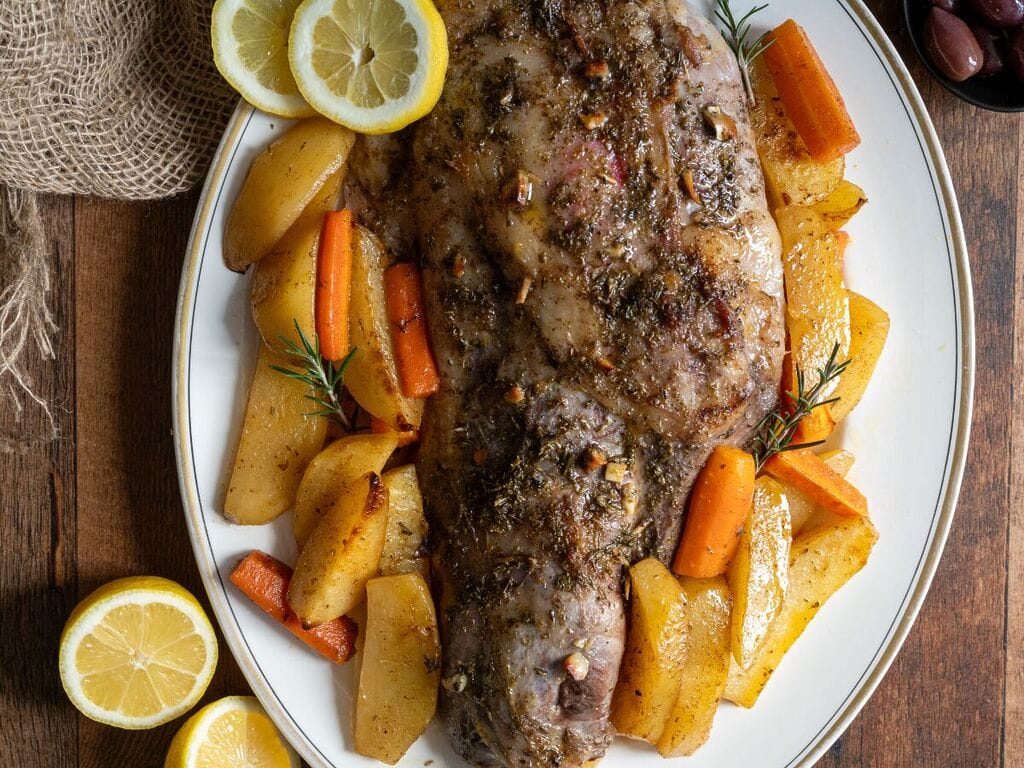
Most Greeks love lamb, and even those who don’t appreciate its unique, game-y flavour will appreciate that they are in the minority of Greeks. Even people who abstain from eating meat will likely acknowledge that lamb is a staple in traditional Greek cooking. Whether it is an entire lamb roasting for Easter, or a rack of lamb on the barbecue, a lamb-based meal usually means that there is something to celebrate; maybe a birthday, a nameday, or a Friday…we should always try to celebrate Friday.
This meal is so great that I feature it in my list of favourite Best Greek holiday meals and is also a meal that I think should be included in Foods you must try in Greece.
Why this recipe works
Lamb tends to be one of the pricier protein choices (at least where I live) so when I do indulge, it’s important that I treat it right. This recipe for Greek roast lamb with potatoes ensures that it is. Despite the fact that it is super simple, and uses only the most straightforward ingredients, the end result is a meal which is purely decadent and worthy of the most important celebrations…like, Easter or Christmas!
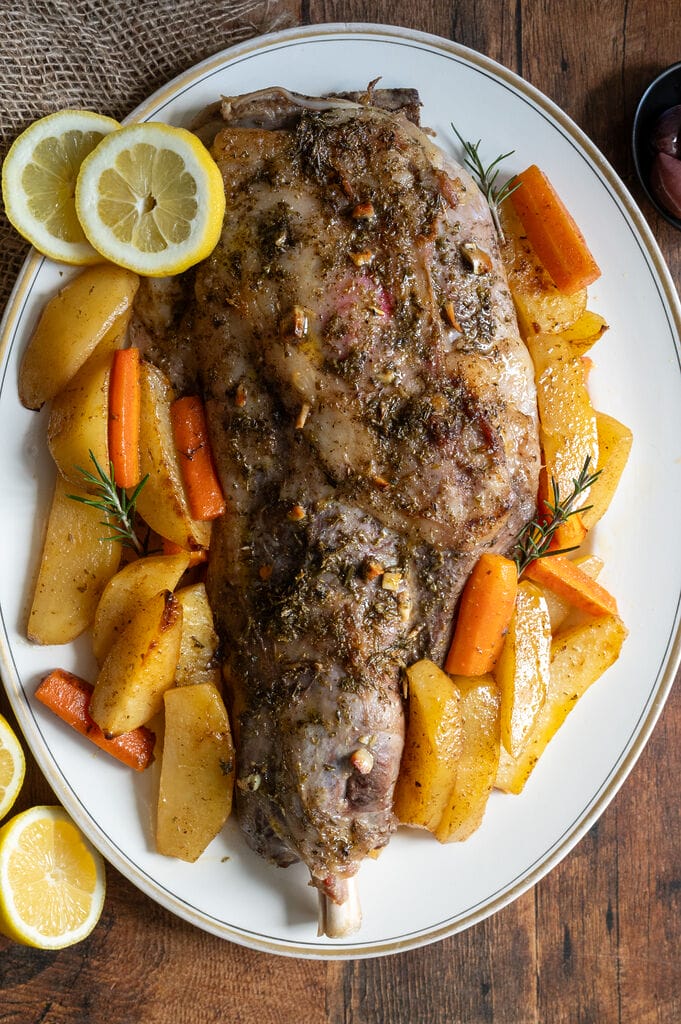
Key ingredients
You only need a few ingredients to make this incredible meal.
Lamb – I tend to use bone-in lamb shoulder when I make Greek roast lamb and potatoes. It cooks up really well, has just the right amount of fat, and always turns out perfect.
Lemon juice – Fresh squeezed is best, and don’t skimp; use as much lemon juice as I do. It is worth it!
Greek oregano – I always use dry Greek oregano in my cooking. You can find this in most Greek or Mediterranean grocery stores, or online. It is really worth it; the fragrance and flavour cannot be beat.
Garlic – I insert slivers of garlic into my lamb. I make small slits throughout the meat and push in slivers of fresh garlic.
Rosemary – I love adding fresh rosemary to recipes containing lamb. The earthy, fresh and strong flavour of the rosemary is just amazing
Potatoes – I use yellow flesh potatoes mostly because I love the flavour and the texture. They are creamy, slightly sweet and so good in this meal.
Carrots – A few carrots added to the roasting pan adds colour, sweetness and a wonderful flavour.
Oil – I actually use a combination of vegetable oil and olive oil in this recipe. In part this is to keep cost down a little bit, but also because you don’t consume the oil – most of it will remain behind in the pan. So, I use some olive oil for the flavour it will provide and the rest is usually vegetable oil.
Paprika – I love to use paprika on my roasted potatoes. It gives a slightly sweet flavour and nice colour.
Salt and pepper – Of course, no meal is complete without seasoning with salt and pepper. Add as much as I suggest, or add to taste.
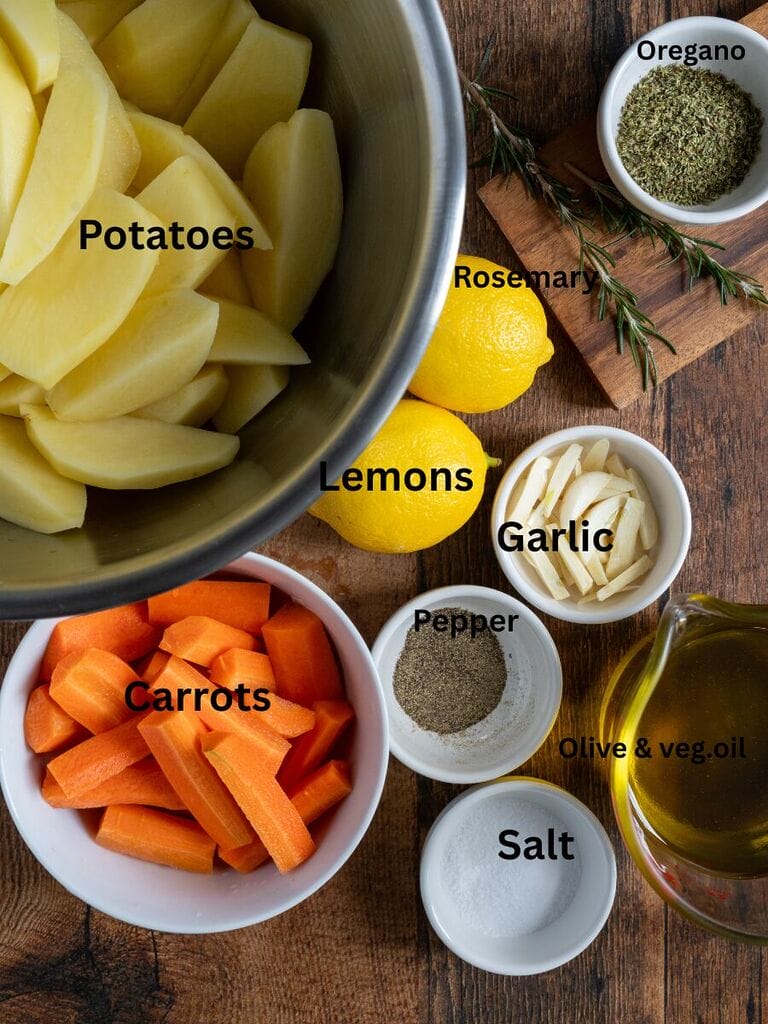
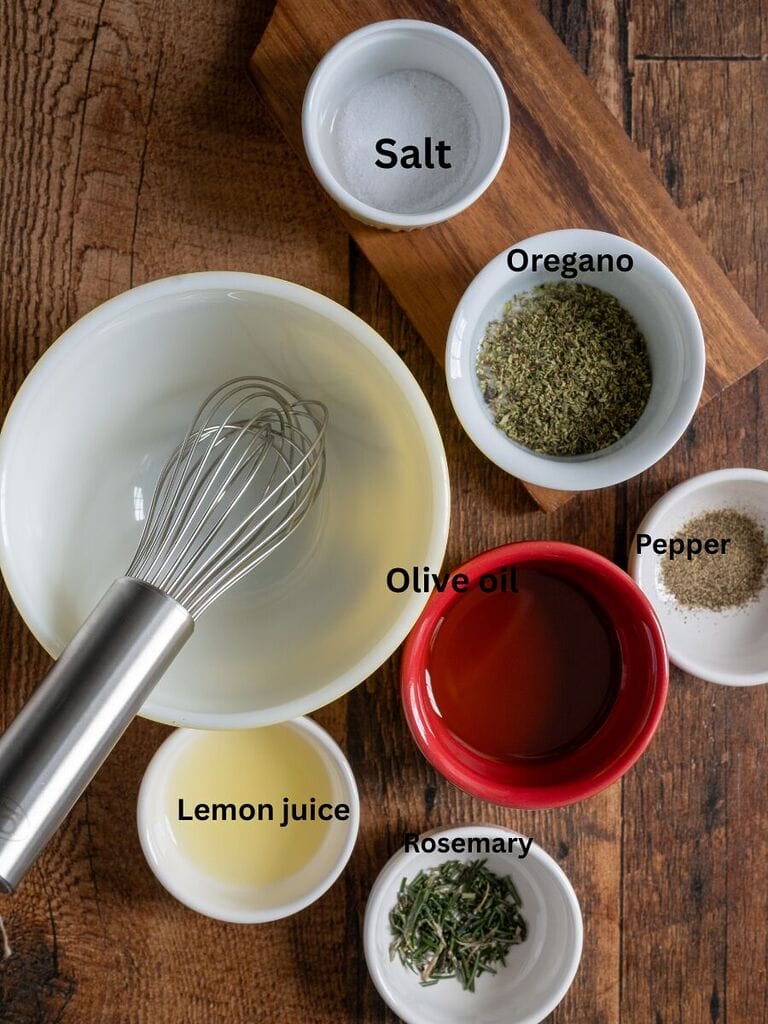
How to make
Many people think that this is a fancy meal, and so it must be difficult to make. Nothing could be further from the truth. You need time for it to roast, but while your meal is in the oven you have time to sip a nice Greek coffee and nibble on a koulouraki.
Preparation
Before you start cooking, take the lamb out of the refrigerator and let it rest at room temperature for at least 30 minutes. This allows it to cook more evenly and ensures a more accurate temperature reading.

Trim any excess fat from the lamb shoulder, then place it in the center of a large pan to coat it evenly with the marinade and to insert the garlic.
Instructions
Step 1 – Prepare the marinade
Combine all the ingredients for the marinade together in a bowl and stir to combine. Set aside.
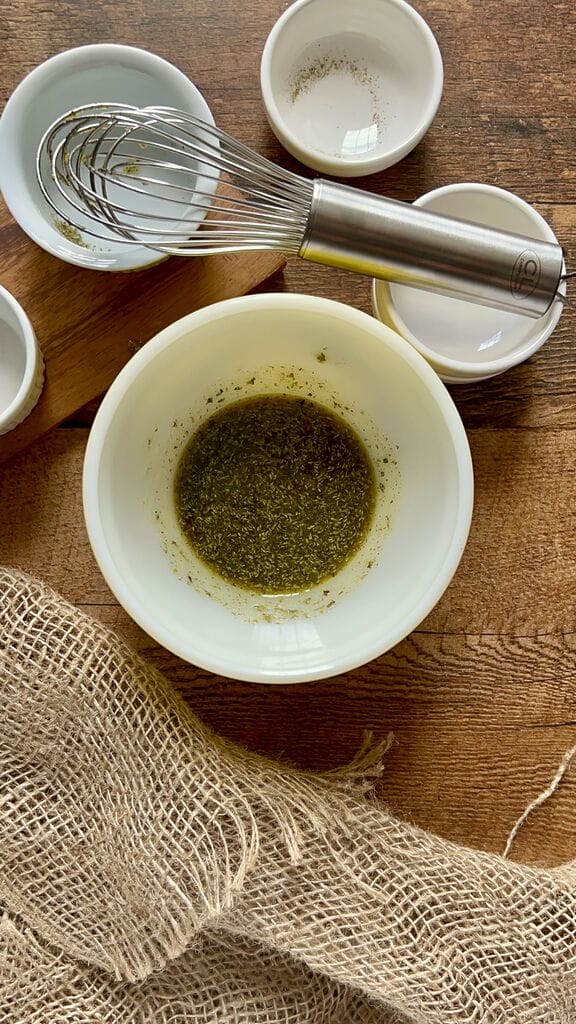
Step 2 – Prepare lamb
Pat the room temperature lamb dry with paper towels and use a sharp knife to make slits all around the lamb shoulder. Insert garlic slivers into the slits and push them in as far as possible.
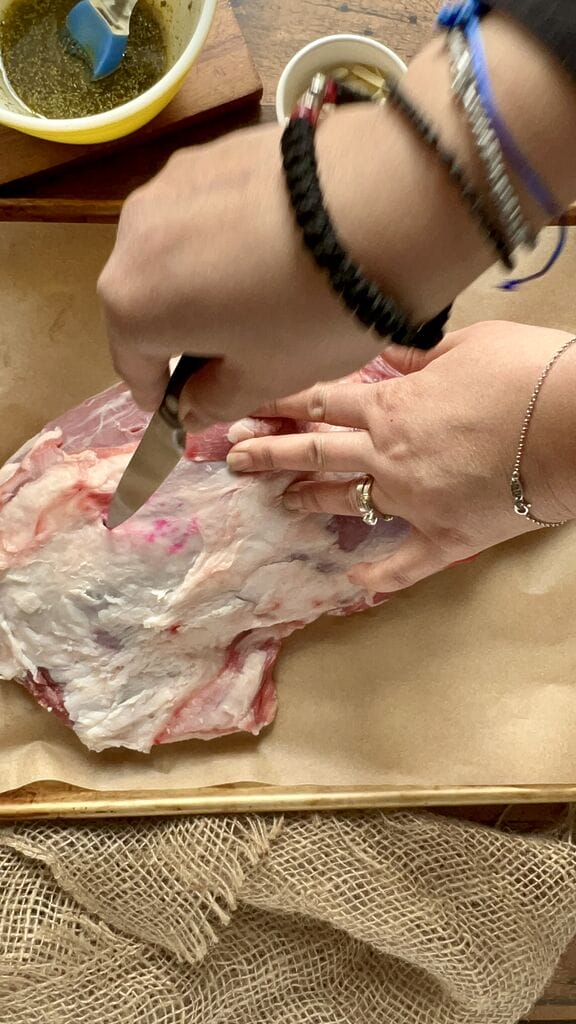
Step 3
Brush the marinade all over the surface of the lamb to ensure that the top of the lamb shoulder is covered in the mixture. If there is any marinade left over, set it aside.
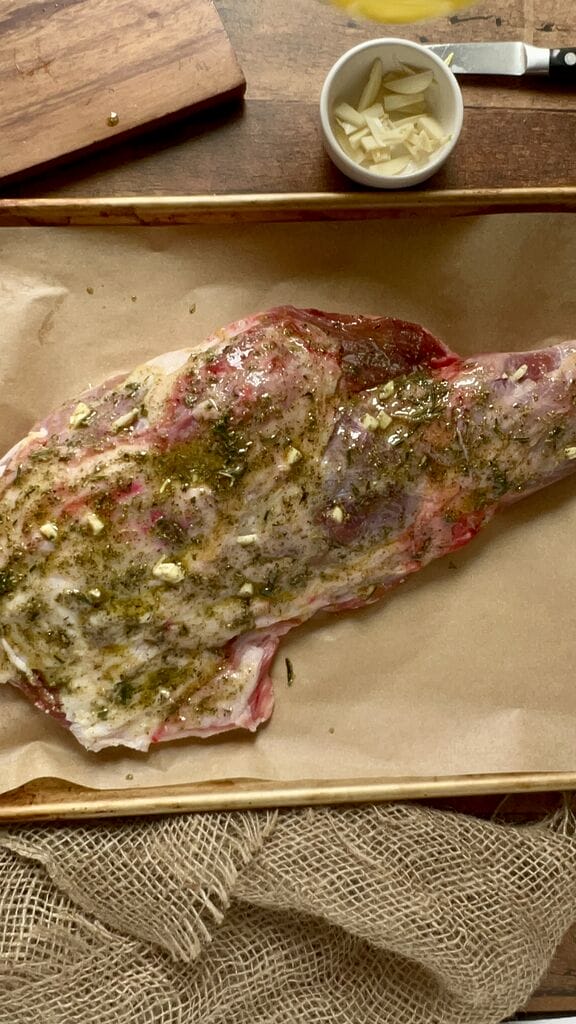
Step 4 – Prepare the potatoes
Peel your potatoes and cut them into wedges. Peel the carrots and cut them into chunks. Combine in a large bowl and toss with the olive oil, vegetable oil, lemon juice, oregano, salt and pepper.
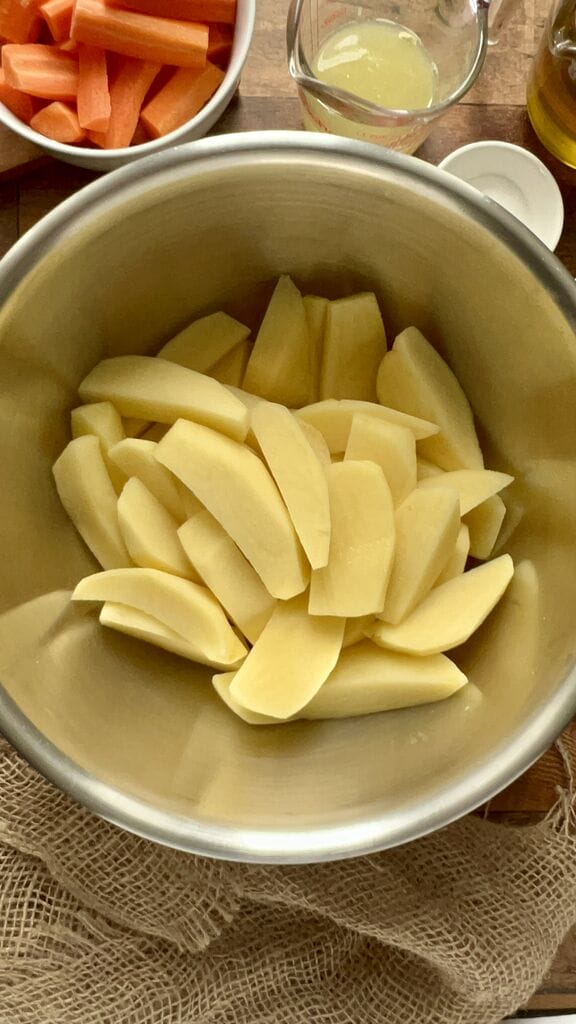
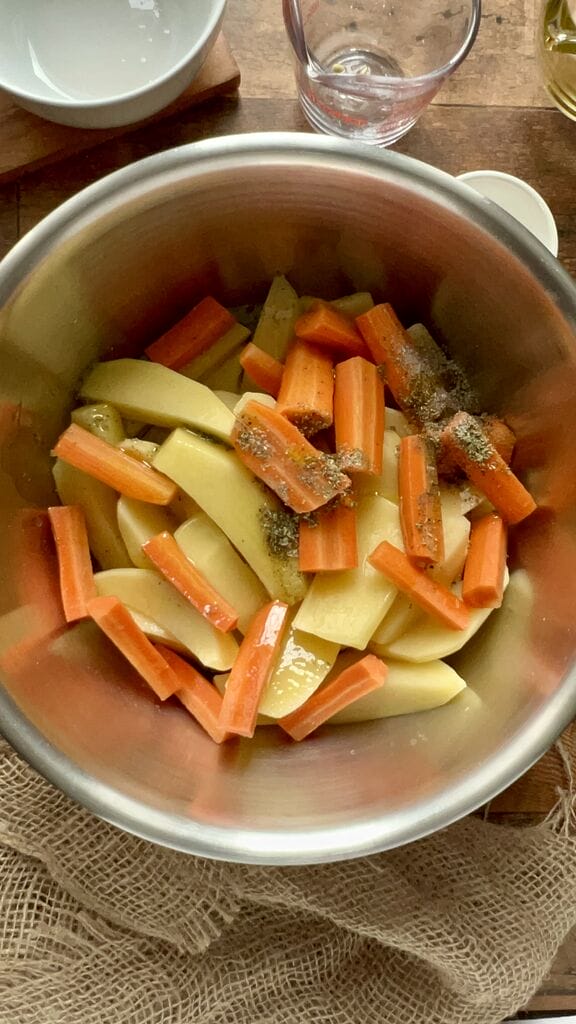
Step 5 – Preheat oven to 450 degrees F. & Assemble the roast
Place your lamb shoulder in the center of a larger roasting pan. Arrange the potatoes and carrots around the lamb shoulder, spreading them as evenly as possible. It is okay if they overlap. If there is any remaining lamb marinade, pour it over the lamb at this point.
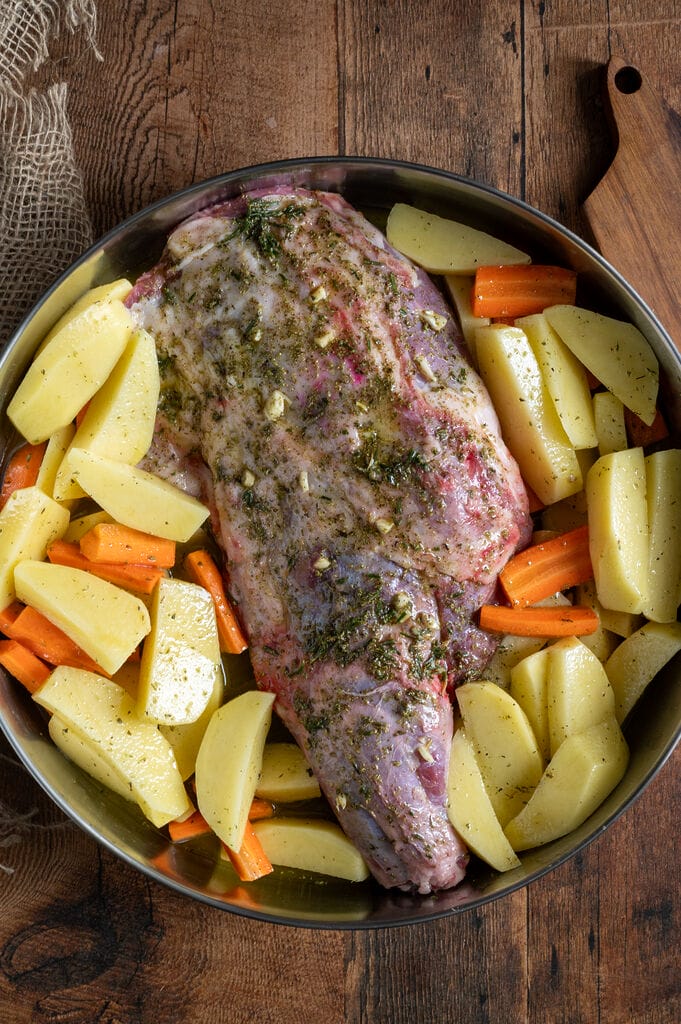
Step 6
Roast in the lower rack of your oven, uncovered, for 15 minutes at 450 °F. Then lower your oven temperature to 360 °F. After an hour of cooking, sprinkle the paprika over your potatoes and stir gently.
Step 7
Continue to roast until your lamb reaches your desired doneness (See Recipe Note). It is best to use a meat thermometer to ensure that your lamb is ready.
Step 8
Once your lamb has reached the desired doneness, transfer it carefully to a cutting board or large platter. Cover it with aluminum foil and allow your lamb to rest for 20 minutes minimally before carving it. This will allow the juices to settle, resulting in more tender meat.
Step 9
Check your potatoes; it is possible that they are not quite ready yet. Turn your heat up to 400 °F. Stir your potatoes well and spread them evenly in your pan. Continue to cook until they are soft and easily pierced with a sharp knife.
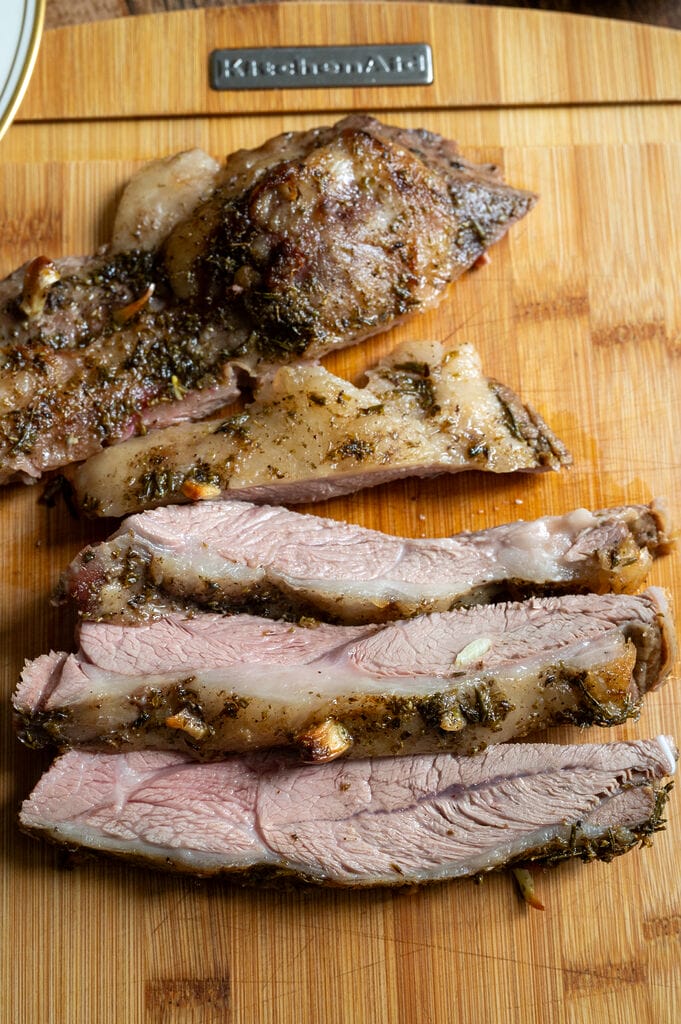
Cooking tips and helpful hints
Checking the internal temperature is the best way to know when your lamb is done
Investing in a meat thermometer is the surest way of knowing that your meat is done. I absolutely love this meat thermometer – it works well, and is not too expensive.
Once you have your thermometer, all you have to do is insert it into the thickest part of the shoulder, being careful not to hit bone. Here is a guide for the temperature you need to reach for your desired level of doneness, and approximately how long it will take.
CHART FOR BONE IN ROAST:
Medium rare – between 130 F to 135 F, approximately 20 minutes per pound
Medium – between 135 F to 140 F, approximately 22 to 23 minutes per pound..
Medium well – between 145 F to 150 F, approximately 25 minutes per pound.
Well Done is between 155 to 165 F, or approximately 30 minutes per pound.
Use the best cut of lamb
The cut of lamb used in this recipe is lamb shoulder. This is a great choice of meat, and if you are careful to purchase a piece which has a little bit of fat on it you will be rewarded with a roast lamb which is moist, flavourful and incredibly satisfying. Whenever possible, it is important to try and develop a relationship with your local butcher, someone you can trust to supply you with the best and freshest cuts of meat.
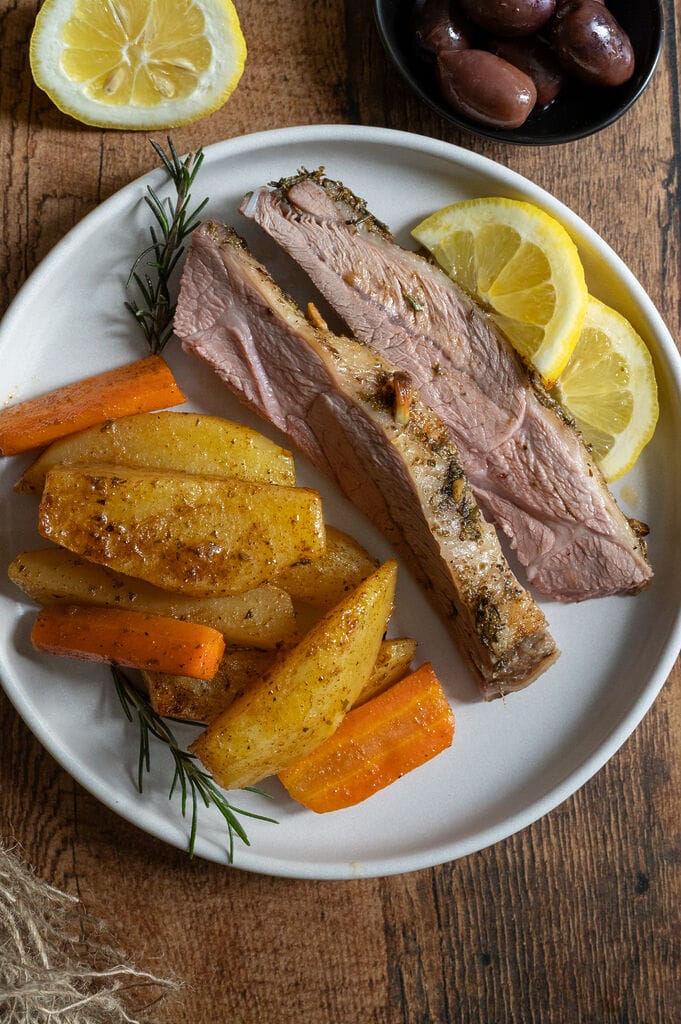
Use plenty of oil
You will notice that there is a fair amount of oil used in this recipe. You may balk. You may cringe. You may try to do with less. I strongly suggest that you do not. The amount of oil used does a couple of things. First, it adds flavour. Second, and most importantly, the way in which the oil coats the potatoes and lamb results in an incredible texture. Remember, although the potatoes do absorb some of the oil during the cooking, a lot of it gets left behind in the pan. It’s not horrible!
The best roasting pan
The roasting pan that my parents use in this recipe is the same one which they use to make their epic roasted chicken and Greek style potatoes. It is a large, round metal roasting pan which is large enough to fit the lamb and potatoes, without crowding them, and without leaving too much free space. Everything fits together nice and comfortably. If the potatoes are piled, one on top of the other, they will steam rather than slow roast. And, if you have too much free space, you’re going to end up using more oil than you need to, which is wasteful. Of course, if you don’t have a round metal roasting pan, another style will work as well. In this situation, it’s really the size that matters most.
Recipe variations
Use a different cut of lamb
You can make this meal with leg of lamb instead of lamb shoulder. You can follow the recipe exactly, both the shoulder and leg are similar hard-working muscles and would need the same cooking method and temperature.
Add vegetables to the roasting pan
Often, when I roast potatoes, I add in a few chunks of carrots to roast along with them, as you can see in this recipe. They end up really sweet and caramelized and add a pop of colour the the finished meal. When I don’t have carrots however, I sometimes add chopped parsnips, or turnips. These are also great options.
Use only olive oil
Although I use a combination of vegetable and olive oil to keep costs down and to have a milder olive oil flavour, you can certainly use only olive oil (actually, you can also use only vegetable oil). The most important thing is to use the same amount of oil as called for in the recipe.
Frequently asked questions
Best potatoes to use for roast lamb with potatoes
My parents tend to use yellow fleshed potatoes when making this meal, and most other roasted meats which they accompany with potatoes. However, they have also been known to use regular russet potatoes, or other white fleshed potatoes. Truth is…if there are potatoes on sale, they will likely buy those and use them in their recipes.
What can I do with leftover roast lamb?
If you do happen to have any lamb leftover you can reheat it in the oven to be enjoyed the next day. Wrap it in aluminum foil and place in a preheated 350 degree oven until heated through. Serve it with some nice sides like Greek lemon rice and some broccoli. You can also turn your leftovers into an amazing lamb sandwich or use it in place of chicken in this always popular grilled chicken bowl.
How do I make the amazing Greek roasted potatoes?
The key to making the best Greek roasted potatoes is time, lots of lemon, and lots of oil. Do not skimp on any of these. You can use any potatoes you like, although I tend to use yellow fleshed potatoes. In this recipe the potatoes also pick up the flavour of the lamb, which is amazing. If you want to only make potatoes however, no problem. You can find the perfect recipe for Greek lemon roasted potatoes here.
How to serve
Carving a lamb shoulder
It is easy to carve a lamb shoulder, if you know how! I could try to explain it to you, but honestly, the easiest thing is to link to this video, which explains really well how to carve a lamb shoulder easily and effectively.
Great sides & desserts
All this meal needs are a few simple sides. A Greek lettuce salad called maroulosalata would be a fresh and light accompaniment to this meal. I also love to serve it with some homemade tzatziki – so good! Finally, to really cap off this meal in a spectacular way, consider making a classic Greek dessert like a galaktoboureko or a baklava. Yum!
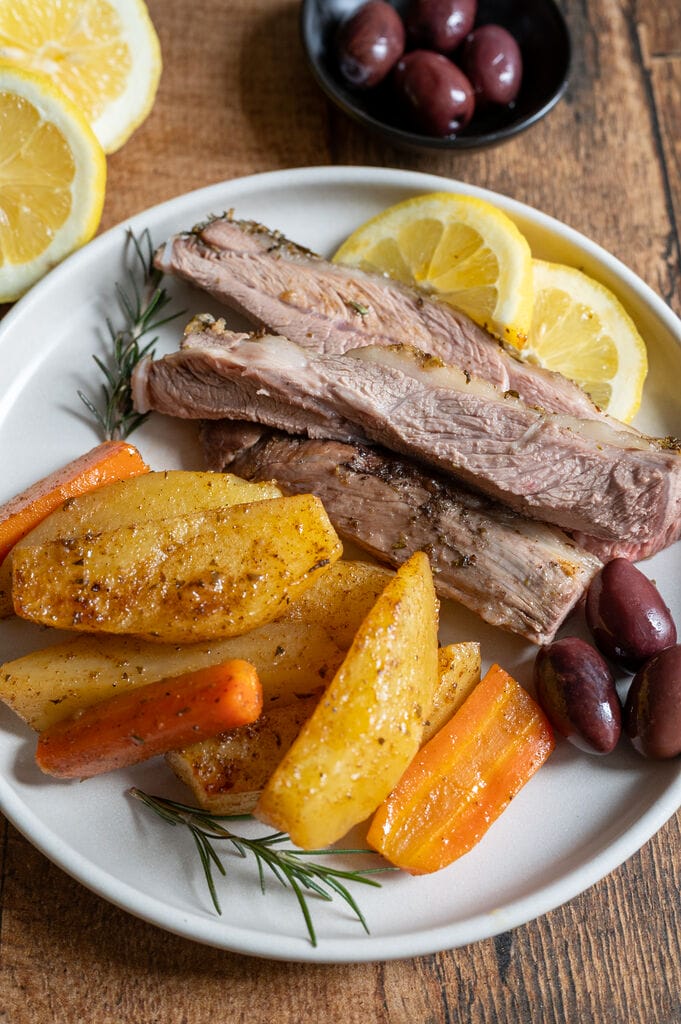
Related recipes
Looking for some more lamb recipes? Check these out!
Lamb burgers with feta Use ground lamb and feta to make this amazing Greek burger.
Grilled lamb chops A real treat, learn how to make the best Greek grilled lamb chops.
Youvetsi with lamb A classic Greek meal of orzo, lamb and tomato.
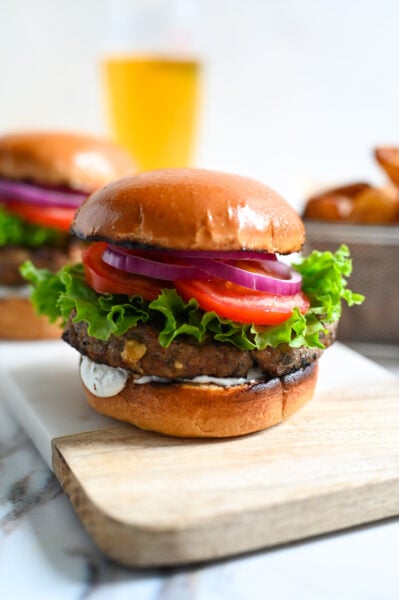

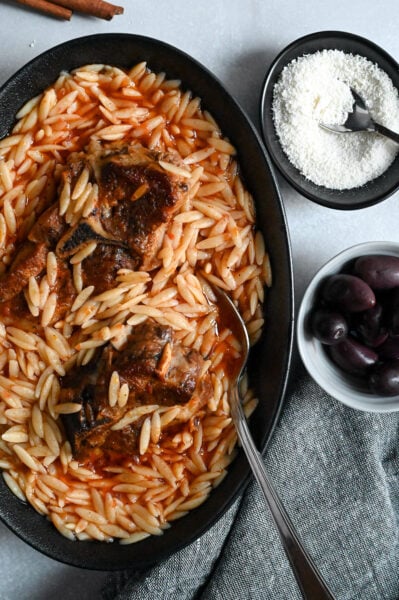

Sign up for our newsletter!
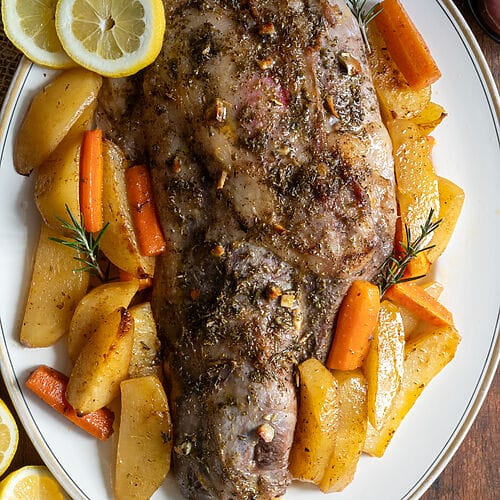
Greek roast lamb with potatoes
Equipment
- Aluminum foil
Ingredients
- 5 pounds lamb shoulder
- 4 cloves garlic, cut into thin slivers
For the rub
- 3 tbsp olive oil
- 1 tbsp lemon juice
- 1 tbsp dry Greek oregano
- 1 tbsp fresh rosemary, chopped
- 1 tsp salt
- ½ tsp black pepper
Potatoes
- 6 large potatoes or 8 – 10 medium size potatoes
- 2 large carrots
- ¾ cup olive oil
- ¾ cup vegetable oil
- ½ cup lemon juice
- 1 tbsp dry Greek oregano
- 1 tsp salt
- ½ tsp black pepper
- 1 tsp paprika
Instructions
- Before you start cooking, take the lamb out of the refrigerator and let it rest at room temperature for at least 30 minutes. This allows it to cook more evenly and ensures a more accurate temperature reading.5 pounds lamb shoulder
- Trim any excess fat from the lamb shoulder, then place it in the center of a large pan to coat it evenly with the marinade and to insert the garlic.
Prepare the marinade
- Combine all the ingredients for the marinade together in a bowl and stir to combine. Set aside.3 tbsp olive oil, 1 tbsp lemon juice, 1 tbsp dry Greek oregano, 1 tbsp fresh rosemary, chopped, 1 tsp salt, ½ tsp black pepper
Prepare lamb
- Pat the room temperature lamb dry with paper towels and use a sharp knife to make slits all around the lamb shoulder. Insert garlic slivers into the slits and push them in as far as possible.4 cloves garlic, cut into thin slivers
- Brush the marinade all over the surface of the lamb to ensure that the top of the lamb shoulder is covered in the mixture. If there is any marinade left over, set it aside.
Prepare the potatoes
- Peel your potatoes and cut them into wedges. Peel the carrots and cut them into chunks. Combine in a large bowl and toss with the olive oil, vegetable oil, lemon juice, oregano, salt and pepper.6 large potatoes, 2 large carrots, ¾ cup olive oil, ¾ cup vegetable oil, ½ cup lemon juice, 1 tbsp dry Greek oregano, 1 tsp salt, ½ tsp black pepper
To assemble and roast
- Preheat your oven to 450 °F
- Place your lamb shoulder in the center of a larger roasting pan. Arrange the potatoes and carrots around the lamb shoulder, spreading them as evenly as possible. It is okay if they overlap. If there is any remaining lamb marinade, pour it over the lamb at this point.
- Raost in the lower rack of your oven, uncovered, for 15 minutes at 450 °F. Then lower your oven temperature to 360 °F. After an hour of cooking, sprinkle the paprika over your potatoes and stir gently.1 tsp paprika
- Continue to roast until your lamb reaches your desired doneness (See Recipe Note). It is best to use a meat thermometer to ensure that your lamb is ready.
- Once your lamb has reached the desired doneness, transfer it carefully to a cutting board or large platter. Cover it with aluminum foil and allow your lamb to rest for 20 minutes minimally before carving it. This will allow the juices to settle, resulting in more tender meat.
- Check your potatoes; it is possible that they are not quite ready yet. Turn your heat up to 400 °F. Stir your potatoes well and spread them evenly in your pan. Continue to cook until they are soft and easily pierced with a sharp knife.
To serve
- To serve your roast lamb shoulder slice it into serving size pieces. See Recipe Note for a link to a great tutorial on how to easily carve a lamb shoulder. Serve with roasted potatoes and carrots, and enjoy!

Why not use all olive oil?
Hi Maria! Great question. Our parents find that using only olive oil can make the meal a tad too heavy. The combination of the vegetable oil and olive oil gives it a good balance. An added bonus, is that it is bit more economical this way 🙂 Hope you enjoy the recipe and thanks for your interest in Mia Kouppa.
What about using a leg of lamb
Sure, leg of lamb would work well as well. We are hoping to post a recipe using leg of lamb, but it will be quite similar to this one.
Looks delicious! No water in the pan for the duration of time it will be cooking? Thank you
Thank you! No, no water required 🙂
It looks delicious and to be honest I have never roasted lamb shoulder, always leg, but I’m going to try this. I’m surprised you haven’t pierced little holes and stuffed them with cloves of garlic. Love your recipes.
Super Mary!! We hope that you love it! The piercing of holes for slivers of garlic we usually do for veal or pork roasts – but you can definitely do it here as well!
Should I triple for 12 people? With other sides?
You can definitely do that as long as your oven can accommodate it! With plenty of sides you can probably also get away with doubling the recipe for 12 people. Individual servings of lamb and potatoes would be smaller however. You can check out our Recipe List for all sorts of sides ideas! Happy Easter! xoxo Helen & Billie
Hi, what do you mean by ”divided” please, thanks Leon.
Hi Leon, It means that you will need a total of 2 tablespoons oregano, but as you will read through the recipe you will see that you divide it’s usage – you will use 1 tablespoon in the marinade for the lamb, and 1 tablespoon for the potatoes. Hope that helps! Let us know if you have any other questions 🙂 xoxo Helen & Billie
400f converts to 204c..x 1.5 hrs…everything burned to a cinder by the time I checked it after 90 minutes. I used shoulder.
Can you review your recipe?
Hi Tony, Really sorry that this was your experience. We have reviewed the recipe and there is no error there. We do find that it is most helpful to use a meat thermometer when roasting meats – this ensures that you reach the proper degree of doneness, especially given that ovens might vary.